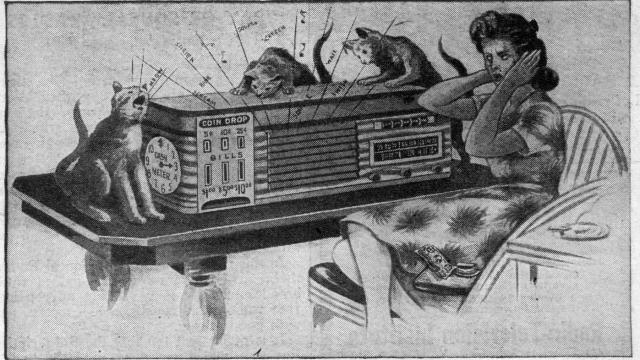We often think of subscription radio as a fairly new idea. But back in the 1940s, one company was trying to make ad-free subscription radio a reality. How would they make sure people paid? By protecting their broadcast from freeloaders with shrieking cat noises.
Understandably, ads weren’t a very popular idea with radio consumers at the dawn of broadcasting. The British had developed an ad-free model paid for by a fee associated with the sale of radio sets. But the Americans went a different way, even if most weren’t terribly happy with the consequences.
Americans of the 1920s hated ads with a passion, and were not shy about calling them absolutely unacceptable. Most people argued that allowing ads on radio would be catastrophic to the medium. How could we allow our homes to be sullied by the obnoxious barking of ad men and charlatans selling everything from stockings to patent medicines?
“Any attempt to make the radio an advertising medium would, we think, prove positively offensive to great numbers of people,” proclaimed one magazine in 1923.
“Advertising by radio cannot be done; it would ruin the radio business, for nobody would stand for it,” explained another publication in 1922.
Below we see a 1922 cartoon with people quite offended by the new-fangled ads that were taking over the airwaves.

But alas, the rise of radio ads happened anyway. Radio broadcasting in the U.S. evolved into a free over-the-air medium paid for by advertising. But that didn’t make people give up hope that there might still be a way to deliver radio without all those annoying ads.
Enter the cat-shrieking scheme.
In the 1940s, there was a renewed push to come up with ways to make radio ad-free. One of the most popular ideas among the radio-nerd press was “subscription radio” which could be unlocked through a special filter attached to a radio set — a bit like paying the cable company to unscramble your porn. A company called Subscription Radio, Inc. even made their case to the FCC.
Under this subscription proposal, three radio stations would be dedicated to ad-free content: one for classical music, another for popular music, and a third for news and talk. All three stations would be absolutely unlistenable if you tuned in on an average radio set — sounding like cat calls and bird whistles, as one magazine described it.
From the March 1945 issue of Radio-Craft magazine:
To confine the service to those who subscribe and pay regularly, an ingenious idea was proposed. A sharp heterodyne whistle would be broadcast with the signal. This would have sufficient volume and ear-splitting sharpness to entirely destroy any entertainment value the programs might otherwise have. Special filters would be attached to subscribers’ sets. These would filter out the objectionable whistles or squeals, leaving only the program with its original high-fidelity.
It was proposed that the filter attachment would cost from between $US6-18 (about $US75-230 adjusted for inflation). Another option that was floated involved a coin box or something akin to a gas meter that would track your use of the service.
In the end, the proposed subscription stations were never implemented. The FCC didn’t want to allocate the radio spectrum for what magazine publisher Hugo Gernsback dubbed “Pay or Squeal” radio. And so Americans simply suffered in relative silence, gritting their teeth through each ad floating into their homes.
Radio advertising was truly seen by many Americans as an assault on the sanctity of the home. But eventually, advertising simply became accepted by radio consumers of the 20th century as a necessary evil — an evil that would ideally be lessened if advertisers could simply keep their messages polite and civilized.
“If it is in any sense an intruder,” one employee of Westinghouse explained in a 1922 issue of Radio News magazine, “it will fail just as an agent at the door is turned away if his appearance or manner is objectionable.”
This, of course, wasn’t always the case, and people of the radio-era continued to struggle with obnoxious ads. They may not have had ad blockers like we do in the internet age, but they sure tried to build them.
Picture: Illustration of an audio-scrambled radio scanned from the March 1945 issue of Radio-Craft magazine; Cartoon from the August 1922 issue of Radio News magazine
